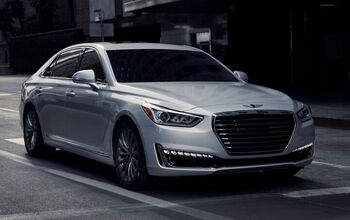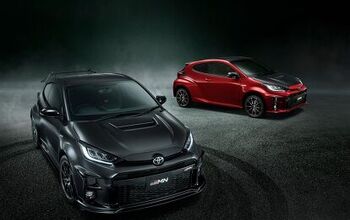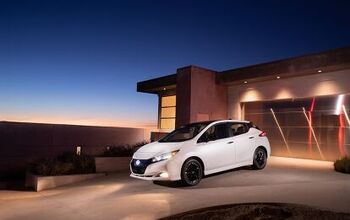Why The Chevy Equinox EPA Mileage Numbers Don't Add Up

TTAC GM Bashing Alert! The following article has been read and reviewed by the TTAC-GM Assault Protective Services Committee and has been found to contain material that may put GM in a negative light. Reader discretion is advised.
Unless the elves are asleep at Google, the odds are good that there will be an ad for the 2010 Chevrolet Equinox immediately to the right of this article. And it will proudly trumpet its 32 mpg EPA highway rating, like every other Equinox ad. From GM’s first gleeful announcement, it was hard to swallow from the that a tall, almost 4,000 lb CUV could actually get 32 mpg on the highway, or 26 mpg combined. It appears others are having the same blockage of the pharynx. Now that there’s a number of reviews out, they all show the same pattern: the Equinox EPA numbers are highly deceptive. But would the EPA ever come down on Government Motors?
We conducted a survey of independent tests that actually measured fuel economy by comparing miles driven versus actual fuel tanked. That alone is important, because the Equinox’ own mileage computer seems to be fairly consistently optimistic by about a couple of mpg. Of course, in this day and age, none too many of the car reviews (including TTAC’s) that are available have actual observed mileage. The majority just regurgitate the remarkable EPA economy that the Equinox is presumably blessed with.
Before we get to that, let’s do the suspect Equinox EPA numbers: FWD 22/32/26 (combined); AWD 20/29/23. Now there’s already a tip-off in just looking at these. The FWD version “premium” (improvement over AWD) is 3 mpg in both the highway and combined numbers. Comparing those to every other comparable CUV that offers both AWD and FWD versions, one finds that the rest of the gang (RAV4, CRV, Outlander, Rogue, Escape) average a 1.4 mpg FWD premium on the highway test, and a 1.0 premium on the combined numbers. The discrepancy with the city numbers is similar: the Equinox has a 2 mpg FWD premium; the rest average a 0.6 mpg FWD premium.
On to the real world: Car and Driver observed 18 mpg with a FWD equinox, and called it “thirsty”.
Edmunds’ test resulted in an 18.8 mpg overall, and made this observation: “Yet our testing didn’t come close to achieving these (EPA) numbers, even though we’re usually within 1 mpg of the EPA combined number.” (emphasis added).
Consumer’s Reports has a carefully calibrated mileage regime that results in very usable comparisons. The Equinox got 21 mpg; that compares to 23 mpg for the RAV4 (24 EPA combined); 22 mpg for the Outlander (22 EPA combined), and pretty much the same for the rest of the competition.
AutoWeek recorded 23.0 mpg as the average of several drivers.
Did anyone actually get close? The GreenCarReports tried to attain the 32 mpg highway numbers by gentle driving with the Eco button firmly engaged. The result: 25.8 mpg, and a comment of “not spectacular”.
A limited degree of variation from EPA numbers is reasonable and understandable, although the revised formula tend to mirror real world experience quite well. But a consistent pattern has emerged with the Equinox and its GMC Terrain stablemate. And its not just against their direct competitors either. Consider the case of its corporate relative, the Chevy Malibu. Equipped with an almost identical I4/6 speed automatic combination, weighing five hundred pound less and with a dramatically lower total aerodynamic drag, the Malibu’s EPA ratings are an almost perfect dead ringer with the Equinox: 22/33/26.
But in the case of the Malibu, those numbers jive with both the competition (Camry: 22/32/26) as well as CR, which recorded a 25 mpg consumption. Hmm.
To assuage the TTAC GM Assault Protective Services Committee’s paranoia, Ford seems to have a similar case of EPA inflation infection. The Fusion Hybrid has been Ford’s poster boy ever since its arrival, trumpeting its 39 mpg combined rating. A survey of tests of it and the very similar 34 mpg rated Camry hybrid shows the same results, literally; as in 34 mpg. The consensus of a number of tests fails to show any measurable difference between the two, except their EPA ratings, of course. CR also tested both at 34 mpg.
Conspiracy theories are not exactly our preferred fall-back explanation, but it really is rather curious that these two particular cars (Equinox, Fusion Hybrid) are both being heavily advertised (despite the Fusion hybrid’s limited availability) as symbols of American auto manufacturer’s ability to deliver class-leading fuel efficient vehicles. And they carry that EPA stamp of approval. Yet neither of them delivers; in fact the Equinox actually underperforms its peers.
Keep in mind that the EPA tests are not actually performed by the EPA, but by the manufacturers themselves, with a small percentage of cars potentially retested by the EPA. Have they retested the Equinox or the Fusion Hybrid? And if they fell short, would we actually ever hear about it?

More by Paul Niedermeyer
Latest Car Reviews
Read moreLatest Product Reviews
Read moreRecent Comments
- Bd2 The "e" nomenclature signifies the e-ATPs which BMW is pursuing.
- Dave M. I'm sorry to see any storied name go away. The lifespan of the Malibu has fit perfectly in my lifetime years-wise. Some of the highlights include the first and second generations, the '78 revamp (very clean design), and the 2005 generation. Ford, GM and Mopar gave this segment away by allowing Toyota and Honda a foot in the door and then always having to play catch-up. How hard is it to make a truly competitive sedan at a profit? Obviously, Japan Inc. figured it out.I've driven a few rentals these past years; the Malibu got the job done but honestly the Passat and Altima were my rental preferences.
- Kcflyer actually yes. It's a shame that a product this uncompetitive can still outsell GM's entire EV offerings. Those products have had billions thrown at them. Imagine how nice the new Malibu, Impala, SS, and Lacrosse would be with that kind of commitment.
- 3SpeedAutomatic Nope....
- Bd2 Looking forward to flooding the rental lots with Hyundai and Kia models, this is just one obstacle now eliminated.


































Comments
Join the conversation
umm being an owner of an equinox and averaging 100 a day in this vehicle with mostly in town driving i can say that i do average 22 in city with 10% ethanol and 24 with straight gas. Additionally averaging 85+ mph for 6+ hours with this thing fully loaded with people and cargo including a tent that went from the back window to the front window still averaged a good 28-29 mpg on 10% ethanol. So I would say that for its size and the power this four banger offers it is unbeatable and correct!!
I bought my '11 equinox AWD 4 cyl pre-owned about 3 months ago. I average consistently 23-24 mpg with about a 50/50 split highway and city. Proof of that is my average mph is always about 30mph. My personal best was an average tank full but with a 150 mile all highway trip and i set the cruise at 65. That tank i averaged 26.4. When driving on the highway at 60 if i reset the mpg computer it always sits about 28mpg at 60-65mph. I'm completely satisfied with the mileage i get. I cant wait to see what i get this summer on vacation into the mountains. I bet i hit the 28-29 no problem. Heres the catch. If you drive this vehicle fast mileage suffers dramatically. Mpg at 60mph is close to 30, at 75 mph its close to 20. Moral of the story is Speed costs money, how fast do you want to go.